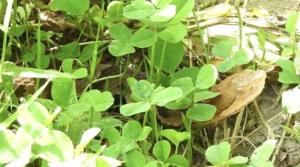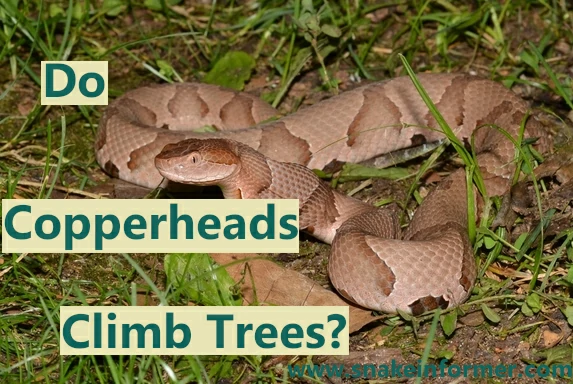Copperheads are thick-bodied snakes found in the eastern portion of North America. These snakes spend most of their time on the ground, but they can utilize a broad range of habitats, at least occasionally.
Copperhead snakes can and do climb low trees or shrubs for various reasons, such as hunting, thermoregulation, escaping predators on the ground, or simply to explore.
These snakes are not very strong climbers like many other species (such as rat snakes), but they are still capable of climbing.
Generally, Copperheads best climb short trees and shrubs in areas with lots of vegetation (such as vines and branches), which they can use as footholds.
They typically don’t go very high off the ground.
Copperhead Snakes Occasionally Climb Trees & Shrubs
Copperhead snakes have a very wide distribution and have adapted to effectively move through a variety of habitats.
These snakes can swim, move across grassy plains, and sand, and even climb short trees and shrubs, with relative ease.
As earlier mentioned, Copperheads are not strong climbers, but they can still make their way up short trees with surprising agility – especially in areas with dense vegetation to provide support.
How Copperhead Snakes Climb Trees
Like many snakes, Copperhead snakes use their flexible, muscular bodies, and rough scales to grip tree bark and branches.
To move upwards, copperheads use a method called ‘concertina locomotion‘, where they grip the surface with side-to-side S-shaped bends, and pull themselves along.

When climbing narrow tree trunks, a Copperhead may wrap its body in a coiled fashion, to gain extra traction.
This helps the snake to inch its way up in a very similar way to how a person climbs a rope.
All snakes rely on surface friction to climb, so Copperhead snakes can only climb trees with rough bark that they can grip with ease.
In general, Copperheads climb best in areas with lots of dense vegetation (such as vines or shrubs).
The vegetation offers footholds and support, enabling the snake to move without having to rely on smooth, vertical tree trunks.
5 Reasons Why Copperhead Snakes Climb Trees
There are several reasons why copperhead snakes may climb trees. They may be searching for a meal, basking in the sun, or just exploring their environment.
Here are 5 reasons why copperhead snakes climb trees:
1. Hunting
Like all snakes Copperhead snakes are obligate carnivores. Their ability to climb trees is very important as they hunt for prey.
These snakes can catch lizards, small mammals, and even small birds in the trees.
They are not picky eaters and will eat almost any prey they can catch and swallow whole (snakes do not chew their food).
They use their sense of smell, as well as their vision to detect and hunt for prey.
2. Predator Avoidance
Copperhead snakes are eaten by a wide variety of predators, such as hawks, owls, small mammals, and even other snakes.
For this reason, these snakes developed several ways to defend themselves.
As a first line of defense, most Copperheads will remain motionless, and rely on their camouflage to blend into their environment.
Their coloration makes them hard to see in thick vegetation.

However, when they are spotted by a predator, these snakes will attempt to escape.
Their ability to climb trees means they can quickly escape predators on land.
Copperheads only strike as a last resort, when they feel they are in immediate danger and have no other choice.
Their bites are venomous and can be serious.
3. Thermoregulation
Like all reptiles, Copperhead snakes are cold-blooded (ectothermic) animals.
This means they cannot internally regulate their body temperature. Instead, their body temperature changes with the temperature in their surroundings.
In other words, their environment is the main influence on their body temperature.
As the temperature changes at different times of day and night, they move around in their environment to regulate their body heat. This is known as “thermoregulation..”
Copperhead snakes may climb into trees to warm up and bask in the early morning sunlight.
During the daylight hours, ambient temperatures are generally higher on the ground than in trees.
However, this occasionally reverses, such as when the ground is cooled by a light rain – and copperhead snakes may climb trees to get warmer temperatures.
4. Avoiding Dangers on the Ground
Sometimes, Copperhead snakes climb trees to avoid various dangers on the ground.
For example, in areas that experience flooding, copperheads may climb trees to escape to safety.
Although these snakes can swim, they still need access to dry land to survive.
5. Exploring Their Environment
Climbing trees is an efficient way for Copperhead snakes to move around in a complex environment, as they explore.
Often, Copperheads will climb trees simply to move across different areas of their habitat.
Copperheads Wont Fall Onto You From Trees
While copperheads can climb trees, they often don’t go very high and do not drop onto humans.
The vast majority of venomous snake bites in the US happen when a snake is accidentally stepped on – or when people have already seen a snake, but try to interact with it rather than just moving away.
While a Copperhead might slip from a branch if startled, it is not an intentional ambush tactic – and it’s very unlikely that the snake will land directly on a person.

The idea of venomous Copperheads dropping out of trees onto unsuspecting hikers is nothing other than a myth.
There is no evidence to suggest copperheads drop from trees to attack or land on people.
If you’re in an area where copperheads are common, keep your eyes on the ground, not the branches above.
Conclusion
Copperheads are ground-dwelling snakes, but they are highly adaptable and more agile than most people think.
They are not strong climbers, but they are still fully capable of climbing trees – especially in areas with thick vegetation to use as footholds and support.
Nearly all snakes can climb trees to some extent when the need arises.
Hi, my name is Ezra Mushala, i have been interested animals all my life. I am the main author and editor here at snakeinformer.com.

